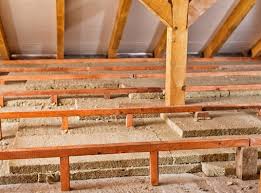Insulation: The First Line of Defense Against the Elements
Insulation serves as the first line of defense against the elements in residential and commercial buildings. Energy Rebates in Florida plays a critical role in protecting indoor spaces from the impact of external weather conditions and environmental factors. Here’s how insulation functions as the initial defense:
- Thermal Resistance: Insulation is primarily designed to resist the transfer of heat. It helps maintain a stable indoor temperature by preventing heat loss in cold weather and heat gain in hot weather. This thermal resistance reduces the impact of extreme temperatures on indoor comfort and energy use.

- Winter Protection: In cold climates, insulation keeps the warmth generated by heating systems inside the building. Without sufficient insulation, heat can escape through walls, roofs, and floors, leading to discomfort and increased heating costs.
- Summer Cooling: In hot climates, insulation helps block the intrusion of outdoor heat, keeping indoor spaces cooler and reducing the need for air conditioning. This prevents overheating and helps maintain a comfortable environment.
- Energy Efficiency: By minimizing temperature fluctuations, insulation improves the overall energy efficiency of a building. Reduced energy consumption means lower utility bills and a smaller carbon footprint, contributing to environmental sustainability.
- Protection Against Moisture: Insulation materials can also provide a degree of moisture resistance. This is important because moisture infiltration can lead to structural damage, mold growth, and indoor air quality issues. Insulation helps prevent these problems by acting as a barrier against moisture intrusion.
- Sound Insulation: Insulation materials can dampen and absorb sound, reducing noise transmission from external sources (such as traffic) and between rooms or floors within a building. This is particularly important for creating a peaceful and comfortable indoor environment.
- Fire Resistance: Some insulation materials are designed to have fire-resistant properties. Fire-resistant insulation can delay the spread of flames, protect structural elements, and enhance fire safety within a building.
- Air Sealing: Insulation often works in conjunction with air sealing measures to create a more airtight building envelope. An airtight envelope prevents drafts, minimizes air leakage, and maintains indoor air quality by keeping outdoor pollutants and allergens at bay.
- Structural Preservation: Insulation can protect the structural integrity of a building by minimizing temperature-related stress on materials. It can prevent issues like condensation, which can lead to rot, corrosion, and other forms of structural damage.
- Long-Term Durability: Properly installed and maintained insulation contributes to the long-term durability of a building. It can extend the lifespan of various building components, reducing the need for costly repairs and replacements.
In summary, insulation serves as the initial and essential defense against the elements. It helps regulate indoor temperatures, improves energy efficiency, prevents moisture-related problems, reduces noise transmission, enhances fire safety, and preserves the structural integrity of buildings. Whether in cold or hot climates, insulation is a critical component in creating comfortable, efficient, and resilient indoor spaces.



